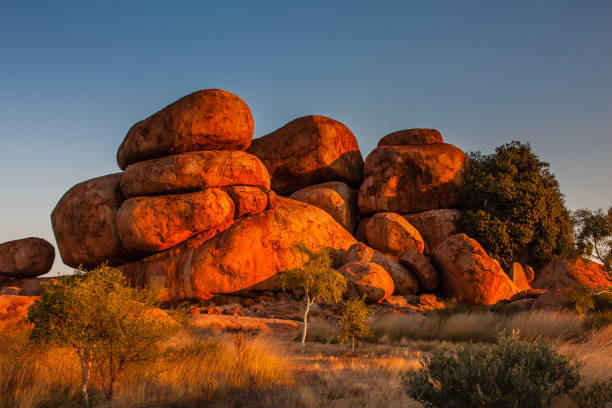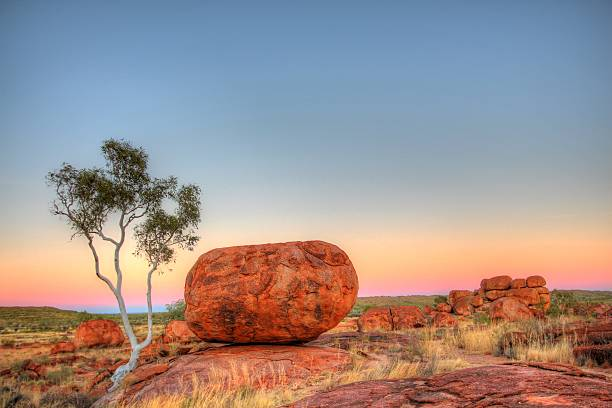
Exploring the Devil’s Marbles: A Journey Through Time and Geology
The enigmatic Devil’s Marbles, known as Karlu Karlu to the local Warumungu people, are an impressive sight located in the Northern Territory of Australia. These large, spherical boulders are actually a type of rock known as granite. But not just any granite – they have undergone a process called weathering, which has shaped them into the rounded formations that intrigue visitors and scientists alike. Let’s delve into the fascinating geological journey that has created this natural wonder.
The Nature of Granite

Granite is an igneous rock, which means it was formed from cooled magma deep beneath the Earth’s surface. It is composed mainly of quartz, feldspar, and mica, and is known for its hard and durable characteristics. This composition accounts for the Devil’s Marbles’ ability to resist erosion to an extent, yet their current form is a result of weathering and erosion working in tandem over millions of years. Through a combination of physical and chemical weathering, the granite rock slowly transformed from massive blocks into the round boulders we see today. The process likely involved the expansion and contraction of the granite due to temperature changes, with water seeping into cracks and breaking down the rock over time.
The Shaping Process
The phenomenon that sculpted the Devil’s Marbles is known as “spheroidal weathering.” This type of weathering erodes the corners and edges of the rock formations more rapidly than their surfaces, ultimately leading to rounded shapes. Several factors influence this process, which includes:
- Diurnal temperature variations that cause expansion and contraction.
- Moisture that freezes and thaws, exerting pressure on the rock.
- Chemical reactions between minerals and water, leading to decomposition.
Initially, the granite exposed on the surface would have been blocky and angular. Over an extensive period – potentially hundreds of millions of years – these edges rounded off, resulting in the boulders’ spherical appearance.
Devil’s Marbles’ Cultural Significance
Apart from their geological interest, the Devil’s Marbles hold a significant place in the local Aboriginal mythology. They are revered as ancient and sacred artifacts, representing the eggs of the Rainbow Serpent, a central creation figure in local Dreaming stories. This cultural significance is recognized through the protection of the site, which is managed in cooperation with the Traditional Owners. The Marbles exhibit evidence of long-term human interaction, such as nearby archaeological findings, lending these rocks a deep historical and cultural context that spans both geological and human timelines.
Conservation and Tourism
Today, the Devil’s Marbles Conservation Reserve offers a unique opportunity for visitors to explore this natural and cultural landmark. Conservation efforts focus on preserving the geological formations as well as the integrity of the sacred site. Here, tourists can learn about both the scientific processes that created the Marbles and the cultural tales that surround them. The Devil’s Marbles are a stark reminder of Earth’s dynamic history and humanity’s place within it, encouraging a respect for nature and indigenous heritage.
Visiting Devil’s Marbles
As a testament to the delicate balance between conservation and tourism, visitors to the Devil’s Marbles are encouraged to engage with the site respectfully. Guidelines are in place to ensure the preservation of the geological formations and to honor the cultural sensitivity of the area. By adhering to designated walkways and avoiding climbing on the rocks, visitors can enjoy the awe-inspiring sight without contributing to unnecessary wear on the site.
Conclusion
In summary, the Devil’s Marbles are an extraordinary example of granite boulders shaped by the forces of nature into captivating spherical forms. Their presence is a display of the strength and endurance of natural materials, as well as the gradual but persistent power of weathering. But beyond their scientific explanation, these stones hold a revered place in Aboriginal culture, reminding us of the deep connections between our planet’s physical features and its human stories. Visiting the Devil’s Marbles carries with it the responsibility of honoring both their natural and cultural significance.
FAQs
1. What are the Devil’s Marbles made of?
The Devil’s Marbles are made of granite, which is an igneous rock formed from cooled magma.
2. How did the Devil’s Marbles get their rounded shape?
The rounded shape of the Devil’s Marbles is due to a geological process called spheroidal weathering that erodes the edges and corners of the rocks faster than the surfaces, leading to a spherical form.
3. Are the Devil’s Marbles a sacred site?
Yes, the Devil’s Marbles are a sacred site to the local Aboriginal peoples and are part of their Dreaming stories, representing the eggs of the Rainbow Serpent.
4. Can tourists visit the Devil’s Marbles Conservation Reserve?
Yes, tourists can visit the Devil’s Marbles Conservation Reserve but must do so with respect for the natural formations and the cultural sensitivity of the area.
5. Why is it important to preserve the Devil’s Marbles?
It is important to preserve the Devil’s Marbles because of their unique geological characteristics, their cultural and historical significance, and their value as an educational and inspirational natural feature.
